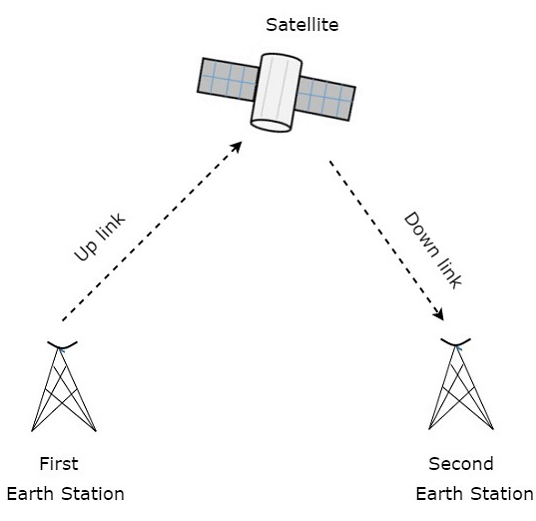
- Satellite Communication Tutorial
- Satellite Communication - Home
- Introduction
- Orbital Mechanics
- Kepler’s Laws
- Earth Orbit Satellites
- Look Angles & Orbital Perturbations
- Launching
- Subsystems
- AOC Subsystem
- TTCM Subsystem
- Power & Antenna Subsystems
- Transponders
- Earth Segment Subsystems
- Examples of Earth Stations
- Link Budget
- Multiple Access Techniques
- Satellite Services
- Global Positioning System
- Satellite Communication Resources
- Quick Guide
- Useful Resources
- Discussion
Satellite Communication - Introduction
In general terms, a satellite is a smaller object that revolves around a larger object in space. For example, moon is a natural satellite of earth.
We know that Communication refers to the exchange (sharing) of information between two or more entities, through any medium or channel. In other words, it is nothing but sending, receiving and processing of information.
If the communication takes place between any two earth stations through a satellite, then it is called as satellite communication. In this communication, electromagnetic waves are used as carrier signals. These signals carry the information such as voice, audio, video or any other data between ground and space and vice-versa.
Soviet Union had launched the world's first artificial satellite named, Sputnik 1 in 1957. Nearly after 18 years, India also launched the artificial satellite named, Aryabhata in 1975.
Need of Satellite Communication
The following two kinds of propagation are used earlier for communication up to some distance.
Ground wave propagation − Ground wave propagation is suitable for frequencies up to 30MHz. This method of communication makes use of the troposphere conditions of the earth.
Sky wave propagation − The suitable bandwidth for this type of communication is broadly between 30–40 MHz and it makes use of the ionosphere properties of the earth.
The maximum hop or the station distance is limited to 1500KM only in both ground wave propagation and sky wave propagation. Satellite communication overcomes this limitation. In this method, satellites provide communication for long distances, which is well beyond the line of sight.
Since the satellites locate at certain height above earth, the communication takes place between any two earth stations easily via satellite. So, it overcomes the limitation of communication between two earth stations due to earth’s curvature.
How a Satellite Works
A satellite is a body that moves around another body in a particular path. A communication satellite is nothing but a microwave repeater station in space. It is helpful in telecommunications, radio and television along with internet applications.
A repeater is a circuit, which increases the strength of the received signal and then transmits it. But, this repeater works as a transponder. That means, it changes the frequency band of the transmitted signal from the received one.
The frequency with which, the signal is sent into the space is called as Uplink frequency. Similarly, the frequency with which, the signal is sent by the transponder is called as Downlink frequency. The following figure illustrates this concept clearly.

The transmission of signal from first earth station to satellite through a channel is called as uplink. Similarly, the transmission of signal from satellite to second earth station through a channel is called as downlink.
Uplink frequency is the frequency at which, the first earth station is communicating with satellite. The satellite transponder converts this signal into another frequency and sends it down to the second earth station. This frequency is called as Downlink frequency. In similar way, second earth station can also communicate with the first one.
The process of satellite communication begins at an earth station. Here, an installation is designed to transmit and receive signals from a satellite in an orbit around the earth. Earth stations send the information to satellites in the form of high powered, high frequency (GHz range) signals.
The satellites receive and retransmit the signals back to earth where they are received by other earth stations in the coverage area of the satellite. Satellite's footprint is the area which receives a signal of useful strength from the satellite.
Pros and Cons of Satellite Communication
In this section, let us have a look at the advantages and disadvantages of satellite communication.
Following are the advantages of using satellite communication:
Area of coverage is more than that of terrestrial systems
Each and every corner of the earth can be covered
Transmission cost is independent of coverage area
More bandwidth and broadcasting possibilites
Following are the disadvantages of using satellite communication −
Launching of satellites into orbits is a costly process.
Propagation delay of satellite systems is more than that of conventional terrestrial systems.
Difficult to provide repairing activities if any problem occurs in a satellite system.
Free space loss is more
There can be congestion of frequencies.
Applications of Satellite Communication
Satellite communication plays a vital role in our daily life. Following are the applications of satellite communication −
Radio broadcasting and voice communications
TV broadcasting such as Direct To Home (DTH)
Internet applications such as providing Internet connection for data transfer, GPS applications, Internet surfing, etc.
Military applications and navigations
Remote sensing applications
Weather condition monitoring & Forecasting